Why NAID-Certified Physical Hard Drive Destruction Makes a Difference

The National Association for Information Destruction (NAID) recently announced that it had commissioned a study of 250 electronic devices resold in the secondhand market and 40% contained personally identifiable information.
Personally identifiable information (PII), or sensitive personal information (SPI), as used in information and security laws, is information that can be used on its own or with other information to identify, contact or locate a single person, or identify an individual in context.
Some of the PII that was recovered includes credit card information, contact information, usernames and passwords, company and personal data, tax details, etc. In the NAID report, PII was found on 44% of the hard drives. While mobile phones had less recoverable PII at 13 percent, tablets were found with the highest amount at 50 percent.
President of AccuShred, Nate Segall says, “This study is exactly why AccuShred will never re-sell hard drives or storage devices intact on the open market. While we could make more money doing this, that is NOT the business we are in. We destroy information, which is why we will always physically destroy every hard drive and phone we receive. I want to sleep at night, and want our clients to do the same.”
AccuShred provides NAID-Certified hard drive destruction. The difference between the process of hard drive sanitation and hard drive destruction is one of certainty. One thing that no one argues is that it is virtually impossible to retrieve information from a hard drive that is physically destroyed. Even proponents of hard drive sanitation warn that there are several vulnerabilities in the process that could lead to “intact” information surviving the process.








